|

|
Number of editions: 22
Edition: June 5, 2004
|

In order to be able to make a good comparison
between the original inland game Capitaly (with
42 spaces concerning Budapest) and Monopoly (the game of Parker Brothers with 40
spaces concerning 8 cities in Hungary) all properties and other
spaces of both game boards will be stated here.
Those 8 cities are resp.: Székesfehérvár
- Kecskemét - Pécs
- Debrecen - Szeged
- Eger
- Sopron and Budapest. The stations remind of those of Budapest but are
merely imaginary railway lines. The position of the stations is such
that the card concerned says "Go to railway line east" instead
of west.
CAPITALY (1986):
Start
- Angyalföld - Szerencsekerék (wheel
of fortune) - Kôbánya - Zugló - B.Sz.K.R.T.
(tram to
Szentendre)
- Király utca - Vagyonadó (property-tax)
- Práter utca - Mester utca - Szerencsekerék - Üllôi út - Rákóczi út -
Margitsziget 10 Pengô belépô díj (Margit
isle Entrance fee 10 P) - Vilmos császár
út - Elektromos művek - Frenc körút - H.É.V. (train
to Szentendre) - Szent István körút - Erzsébet
körút - Szanatórium - Sashegy - Fényüzési adó (luxury
tax) - Rózsadomb - Gellérthegy - Gázművek
- Szerencsekerék - Károly király út - M.Á.V. (Hungarian
Railways) - Stefánia út - Andrássy út - Házadó
(house tax)
-Szabadságtér - Osztálysorsjáték (lottery)
- Kossuth Lajos tér - Vörösmarty tér - Névnap (name
day) - Szerencsekerék - Dorottya utca -
Telefon and Váci utca.
MONOPOLY (1996):
Start
- Piac tér - Meglepetés-kártya (surprise
card) - Török udvar - Jövedelem adó
(income tax) - Északi vasútvonal (north railway line) - Nagykôrösi út -Szerencse-kártya
(luck card)
- Lestár tér - Kisfaludy út -
Börtön/Csak látogatóban (jail
- just visiting) - Egyetem utca -
Elektromos társaság (electric
company)
- Színház tér - Janus Pannonius út -
Keleti vasútvonal (east
railway line) - Petôfi tér - Meglepetés-kártya
- Nagyerdô - Bethlen utca -
Ingyen parkolhatsz! (free
parking) - Móra park - Szerencse-kártya -
Oskola utca - Dóm tér - Déli Vasútvonal
(south
railway line) - Dobó tér -
Almagyar utca -
Vízmű
társaság (water
works)
- Gárdonyi út -
Irány a börtön (Go
to jail) - Kôfaragó tér -
Óváros -
Meglepetés-kártya - Ötvös utca - Nyugati vasútvonal
(west railway line) - Szerencse-kártya - Vörösmarty
tér - Pótadó (extra
tax)
and Dunakorzó.
"Teljesítsd a tervet"
("Carry out your plan")
In the March 3, 2001 edition of the Hungarian paper "Hetek" Katalin Laudancsek
writes (see: http://www.hetek.hu/index.php?cikk=9739)
in her article "Kész kapitaliszmus" (a detailed
article about the history of Monopoly) a.o.:
"During the 2nd W.W. the name Capitaly
for Monopoly
came into fashion and since it endured many metamorphosises of both its name
as well as the nature of the game.
In 1952 the government started to forbid a lot of things called malignant
outgrowths of the languishing imperialism. From this time date the hand
drawn and colorful press cutting decorated copies. (Who
owns such a game board?) In that era it wasn't sensible
to shout into the street "Come and play Capitaly".
So the political leaders found a way to fill up the void arisen after the ban
of the popular game with a "comrade friendly" version. That became "Teljesítsd a tervet"
("Carry out your plan"),
where the aim of the players (finally all representatives of a socialist
country) is to obtain a higher standard of life, despite interfering
activities of the enemy (as there are the capitalists, war incites and bad
students).
Next the wheel of history turned a bit forward which inevitably caused certain
changes: In the Kádár era (János Kádár, 1956-1988) the well-known Gazdálkodj okosan!
(sneeringly called "Szocialy") arose enduring changes over the
passed 4 decades, being worth a study on its own. In the beginning furnishing
a simple apartment was the top: furniture, TV, refrigirator, vacuum
cleaner and the like. In the seventies it became family houses and in
the eighties people could easily afford a weekend house.
Of course this was very far away from Monopoly. The main difference is
according to Ferenc Hammer, sociologist,
while originally earning money is the main issue, in socialist
games it is rather spending it (however after performing
useful labour). In the ruthless fight collecting fortune is at stake
with Monopoly (Capitaly), while one ought not exert oneself with the
east european "intelligent policy pursuing", because everything in
the state depends on counters and a little bit of luck, meanwhile quietly
waiting slowly proceeding in the queue, preferably leaving the others alone.
Hungarian capitalist mentality does not stand for fighting."
Edition: Capitaly (of the precommunist
period '35-'46)
Publisher: unknown
Dimensions of the box: 35.5 x 25.5 x 3.0 cm
The game:
This is an inland version of the monopoly game that, like the Parker Brothers',
must have been issued around 1935, because the currency Pengô was in use
in Hungary from 1927 till mid 1946. In addition the banknotes have a kind of "engines-pattern"
that resembles that of Parker Brothers' but with 2 engines and 2 houses left and
right from the circle-with-number-in-the-center. Everything indicates an imitation rather than a
licence of Parker Brothers.
See for the description the one of the re-issue of 1986.
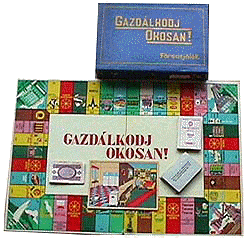 Edition: Gazdálkodj
Okosan! - communist Edition: Gazdálkodj
Okosan! - communist
(Pursue an intelligent policy!)
Publisher: Alföldi Nyomda - Debrecen - ±1960
Dimensions of the box: 29 x 20 x 6 cm
of the board: 41.4 x 60 cm
The game:
The workmanship of this game of the communist period (1946-1989) is obviously
very poor. The big game board is made of heavy cardboard and is in a
large envelope. The equipment is in a smaller but solid blue
box. The rules say the game is for 2 to 7 players, but apparently
the banker is one of them, because there are but 6 tokens.
Aim of the game is to save that much that a house can be bought
and subsequently furnished with goods like a vacuum cleaner, living room
furnishing, kitchen furnishing, radio, washing machine and a sewing
machine. The first player to furnish the house and additionally
has saved at least 2,000 Ft in saving bonds is the winner.
To that end each player get a house-plan in which he has to fill up 6
parts. The house can only be bought at O.T.P. (19), where as the furnature
can be bought at space (11). At space (33) one can buy all domestic
appliances at Keravill's.
Very striking of this "party game" is clearly pedagogic second
objective. That does appear from the pedantic phrases of some Chance cards
like:
 |
Go to the cinema! The movies are instructive and entertaining. Advance to
space (17) and pay 10 Ft. |
 |
Exercise is healthy and entertaining. You should exercise as well. Advance
to space (7). |
 |
Read! Reading is pleasant, useful and cheap entertainment. |
 |
You have dirtied the street! Pay 10 Ft. |
The scene is laid in Budapest and vicinity appearing from the fact that a stroll
can be taken over the Margit isle (26), go to the Fishermen's Bastion
(29), make a trip over the Donau to Visegrád (38) and one may/have to stay 2
turns at Lake Balaton.
A few other fields are: a shoe-shop (14), a cinema (17),
a tobacco-shop (20), a confectioner's shop (24), a stores (28) and a theatre
(36).
There are 41 spaces in total, of which 6x Szerencsekerék (Wheel
of Fortune). There are 46 Wheel of Fortune cards
(60x90 mm) but these
cards have no illustration. There are 60 savings bonds (58x88 mm) of 1000 Ft and 30
savings bonds of 5,000 Ft. The money consists of 6 neutral banknotes
printed in color on white paper: 10 - 20 -
50 - 100 -
200 and 1000 Ft. Each player receives 4,000
Ft at the start of the game. On/over Start you receive 4,000.-/2,000 Ft
as wages.
The price of this set amounted to 52.40 Ft at the time of issue.
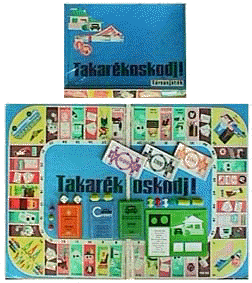 Edition: Takarékoskodj!
(Save!)
- communist Edition: Takarékoskodj!
(Save!)
- communist
Publisher: TRI-TON HSZ - ±1980
Dimensions of the box: 29 x 20 x 6 cm
of the board: 41.8 x 60 cm
The game:
As this is also a game the solid board of which does not fit in the box
and the finish is plain but solid it is obvious to compare it with the game
"Gazdálkodj okosan!" But since the amounts are about a factor 10
higher it is likely to assume that thís issue is published much later.
Aim of the game is to become the first to possess a house with 3
rooms, a car, a weekend house as well as 10,000 Ft in bonds. This is
not exactly a game of which the aim is to become capitalist by obtaining monopoly
over a real estate empire. It is rather a game, as can be expected in a
communist society, of being careful with your money and so enjoy as much
as possible by having a weekend house as well as making trips on a motorbike to
the Danube-turn (27), with the car club to Venice or Paris (35), by bus abroad
(22) or by own means for a summer vacation in a foreign country (36).
There are 6 green Családi ház
(family house)-cards, so the game can be played by
6 persons plus a banker. The momentone lands on one of the 6 fields with this
title one may buy a property deed for 80,000 Ft. On a similar next field
you can start building the first (of 3) room. For that you have to
make a down payment of 10,000 Ft while the bank lends 15,000 Ft. This will be
shown by yellow and blue
plastic chips the banker will place on your property deed. The next rooms may
not be built until the previous one has been paid off. It is important you
take out a real estate insurance because on your way you will meet rather
a lot of reverses.
Next you can purchase one of those nice but tiny racing cars on field
(17) or (30). It's not only the price of 68,000 Ft you have to pay, but also the
legal liability+accident+luggage insurance at the price of 450 Ft. But
in case you bought a profit participation for 5,000 Ft on one of the
fields (20) or (41) it is likely you'll get a letter reporting you
can collect a car at the bank. On field (28) you must take out an insurance
on bodywork at 3,000 Ft.
On one of the fields Pilis (6, blue),
Mátra (8, green), Börzsöny
(18, blue), Balaton (25, green),
Dunakanyar (32, brown) and Velence
(42, brown) a weekend house can
be erected consisting of 2 oblong, yellow
buildings.
The building site cost 50,000 Ft, after which you can start erecting the
buildings for 25,000 Ft each. In case another player lands on your property he
has to pay you rent, unimproved 1,000 Ft, with one building 1,500 Ft and
with 2 buildings 2,000 Ft.
Finally you can always buy savings bonds, which causes a 5% interest on
field (3) and (24). But in the course of the match you will also encounter reverses,
because on:
(2)...you have to pay for Toto.
(7)...you can catch a cold, for which you have to
omit two turns.
(10) your house sustains fire damage; you lose one room.
(12) you drive your racing car total loss. In case you have an insurance you'll
get 40,000 Ft compensated
against hand in of the banger and in case you are not
insured you'll get nothing.
(16) you have to hand in all your insurance policies.
(21) and (39) you have to pay tax for your car (600 Ft), your house (300 Ft) and
your weekend house (150 Ft).
(33) there was a burglary at your house. If you were insured you'll receive
2,500 Ft from the State Insurance
Bank, but if you were not insured you must pay
3,000 Ft.
There are 42 fields in total (because Start is the first), of which 5
are Levél (Letter), a kind of Chance card
therefore. There are 30 Letters for which there is no field on the game
board but who are under control of the banker.
Some of the instructions
are:
 |
You have founded a family. Because you will take care you decided to take
out a life insurance. Pay 1,000 Ft. |
 |
It was your birthday and you had invited your friends. That party had cost
500 Ft. Pay that amount to
the bank. |
 |
You had such a good idea at your works that is was accepted. You will
immediately receive a
reward of 1,500 Ft. |
There are 60 savings bonds of 10,000 Ft and 30 savings bonds of
20,000 Ft. The money consists of simple neutral banknotes of various
colors in the denominations of 50 - 100 - 200 - 500 - 1,000 - 5,000 and 10,000
Ft.
Each player receives 100,000 Ft at the start of the game. On/over Start
you receive 10,000.-/20,000 Ft.
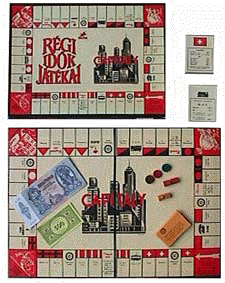 Edition: Capitaly,
régi idôk játékai (from the series Nostalgic
Games) Edition: Capitaly,
régi idôk játékai (from the series Nostalgic
Games)
Publisher: Tücsök (Cricket) - Budapest -1986
Dimensions of the box: 35.5 x 25.5 x 3.0 cm
of the board: 33.0 x 48.5 cm
The game:
The lid of the box shows a slightly reduced copy of the oblong game
board in the colors red, beige
and black.
The long sides always have 12 fields between the corners whereas the
short ones have 7 spaces. Therefore the streets of the 3rd and
7th group
are on 2 sides of the board. The first group is made up of districts of PEST,
those of the 5th group of districts of BUDA, whereas all other spaces are
streets of BUDAPEST. The back side of the pretty beige
colored property
deeds is unprinted.
The streets have no prices on the game board, whereas the group is marked by
stripes, triangles, crosses and circles.
There are but 3 stations who in addition are not situated in the middle
of the sides. On the other hand there are also 3 public works, viz.
besides the Electric- and Gas Works Telephone as well. There are 3 tax spaces.
Really Hungarian is the reward of 500 P you get from each player on your name
day (Névnap).
The lid and the board's midfield shows an illustration of the New York skyline with the remark "statutory protected".
In the centre-area is only 1 space for cards being the 24 orange
Chance-cards you have to pull arriving on a Wheel of Fortune space.
Instead of "Just visiting in Jail" you are going to relax at the
Margit Isle (in the middle of the river Donau). You are not sent to this place
in the 3rd corner because there you'll join in a lottery. There you have to
throw immediately once more. You'll receive 10-fold in Pengôs from the bank the
number of pips thrown. Should you throw 12 you even get the first prize of
10,000 Pengôs. Instead of Free Parking you'll land in the Sanatorium. You may
be sent to it as well by a Chance card, because "You are exhausted, you
have to be treated - Go to the Sanatorium!". It is a kind of jail anyhow,
because here again you have to omit 3 turns.
In the inner box is an insert of black plastic contaning 5 trays for
the equipment. The 7 are printed in black on
colored paper in the denominations 10 - 50
- 100 - 200 -
500 -
1000 and 5000
Pengô. The tokens consist of 6 colored round discs
of timber. There are 32 beige houses
of mat raw timber and 12 red hotels.
Of both dice1 is black and 1 is red.
Edition: Gazdálkodj (DE)
okosan!, without ref.nr.
Publisher: is not mentioned (V-sign and cloverleaf) - ±1990
Dimensions of the box: 21.0 x 30.0 x 4.7 cm
of the board: 41.3 x 56.8 cm
The game:
This is a modern version of the communist game based on the purchase and
the furnishing of a house. Besides the complete furnished house and at
least 5,000.- Ft in saving bonds the winner must have for 400.- Ft
in book tokens in addition.
This version ("Pursue (but) an intelligent
policy") with light
blue lid, is a simple issue of the game. The game board is of soft
cardboard. It looks like the publisher has designed it in a great hurry,
because on field (6) one should pay 150 Ft whereas there are no banknotes of 50
Ft in the game. And on field (28) he forgot to print an instruction.
Besides the house-plan now contains 9 parts to be filled in the
furnishing is obviously more luxury. As well as for the well-known vacuum
cleaner, living room furnishing, kitchen furnishing, radio, and washing
machine you should also save for a refrigerator, TV, bicycle and a ping-pong
table.
After you have bought a house on hire purchase at the spaces (14) or (26) you
can begin to furnish. For that purpose one can buy the domestic appliances, viz.
the TV, radio, vacuum cleaner, refrigerator and washing machine in the
"specialist shops" at the spaces (4) and (34). Space (29) is a "Furniture
and Sport" shop where one can buy the living room- and kitchen furnishing,
the ping-pong table and the bike. In the stores at the spaces (7) and (13) one
can obtain all goods of spaces (4) and (29).
The game has kept its pedagogic second objective. And although there
are of course many new instructions on the Chance cards there are again
those pedantic phrases like:
 |
Have fun at the theatre and the cinema! Advance to field (18)! The price
of a ticket for the theatre is 200.- Ft, that for the cinema is 100.- Ft. |
 |
Exercise is healthy and entertaining. You must go exercise as well.
Advance to field (19). |
 |
Reading is nice, useful, entertaining and stimulates your education. You
may buy a book tokens, 200.- Ft. |
 |
Smoking is bad for your health, however you lighted one up. Omit two turns! |
The sole space that reminds of Budapest is the VIDÁM
PARK.
Some other fields are:
 |
"Every morning you practice gymnastics. Advance for that purpose 3
spaces!" (19), |
 |
"You keep yourself clean (brush your teeth in the morning and in the
evening). As a reward you may throw the dice twice!" (21), |
 |
"In your free weekend you've made a trip in the countryside. Throw
again!" (39). |
There are 39 spaces in total, of which 6x Szerencsekerék (Wheel
of Fortune). There are 50 Chance cards with an
illustration of the Wheel-of-Fortune. There are 60 savings bonds of 5,000
Ft and 30 savings bonds of 10,000 Ft. Furthermore there are: 6
policies of the CSÉB (Insurance
company), 12
book tokens and 6 house insurance policies. The money consists
of simple narrow banknotes. The only 4 banknotes have been printed in
color on white paper in the denominations 100 - 500
- 1000 and 5000
Ft of the National
Hungarian Bank. The one die is white with green
pips.
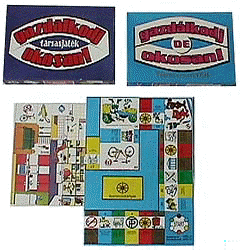 Each player receives 20,000
Ft at the start of the game. On/over Start you receive 6,000.-/4,000 Ft. Each player receives 20,000
Ft at the start of the game. On/over Start you receive 6,000.-/4,000 Ft.
The price of this set amounted to 1,390.- Ft (= € 7,70) July 1997.
Edition: Gazdálkodj (társasjáték)
okosan!, without ref.nr.
Publisher: is not mentioned (cloverleaf and forint) - ±1990
Dimensions of the box: 22.2 x 30.0 x 6.0 cm
of the board: 41.8 x 58 cm
The game:
This is apparently the Delux edition of the previous set. In the box with
dark blue lid is now a twice folded
game board of strong cardboard. That makes playing more confortable anyhow.
Aim of the game is again to aquire a house and to collect as many
properties as possible. The house-plan with 9 parts is now twice
as big as those of the cheaper edition, but for the rest all accessories are
very precisely the same (including the errors on field (6) and (28)), so this
must be an issue of the same unknown publisher.
The price of this set amounted to 1,990.- Ft (€ 10,85) July 1997.
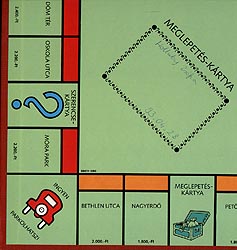 Edition: Standard,
ref.nr.6951H1092 Edition: Standard,
ref.nr.6951H1092
Publisher: Parker Bros./Hasbro Magyarország Kft. - 1992
Dimensions of the box: 26 x 50.5 cm
The game:
In Hungary this official Parker Bros. game is even better known under the name Capitaly.
This game was introduced in 1992 and is manufactured in Ireland.
Unlike the sets of most European countries of the nineties the lid of
this box does not show "the collection of attributes" but instead the
4th side of the game board precisely like the games from 1985. Neighter the
bottom does have a color picture of a "laughing family", but a black/white picture of the board with equipment.
The design of this edition is clearly a merging of that of the games of 1985 and
1992.
There are those well-known 10 metal tokens: dog - thimble - hat -
wheelbarrow - iron - canon - rider-on-horse - shoe - boat and car. The green
houses (with chimney) and red hotels
are of plastic.
The manufacturer had processed the pink Szerencse-
(Chance) and blue Meglepetés- (Surprise) cards a bit inaccurate, because:
 |
The text on 2 Chance cards says they are Surprise cards. So there
are 2 Surprise cards of which the text says they are Chance
cards. Besides an annoying error has been made. |
 | The card "Go back 3 spaces" is now in the Surprise
stack.
That means that one may land on Dunakorsó (2nd dark
blue street), Janus Pannonius út (3rd purple
street) and Irány a Börtön! (Go to jail!). This cannot has
been the intention. |
 |
We do not know a card saying "Proceed to Nagyerdô (2 spaces before Free
Parking)". However, this is an additional opportunity to
be sent over Start. |
It is striking that the courtesy form of you as it is in
Capitaly is
no longer used.
The price amounted to 3,400.- Ft (€ 20,-) in the expensive Fontana Aruház
(department store)
July 1995.
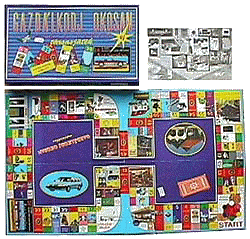 Edition: Gazdálkodj
Okosan új (new),
b.c.623452 Edition: Gazdálkodj
Okosan új (new),
b.c.623452
napjainkban társasjáték
(contemporary party game)
Publisher: is not mentioned - ±1994
Dimensions of the box: 22 x 36.5 x 5 cm
of the board: 41 x 66 cm
The game:
That this is a more recent set than the others is to be seen from the
devaluation; each player receives 35,000.- Ft at the start of the game
and on or over Start you'll get 6,500.-/5,000.- Ft.
Aim of the game is again to aquire a house and to collect as many
properties as possible. (You don't need to posses saving bonds nor book tokens
any more!). Besides the soft game board everything is more luxury than
previous issues. The 6 house-plans are now devided into 18 parts
for which the again more modern goods have to be acquired, like a computer
(6), video-camera (13), mobile telephone (20), car (24), dish-washer (46),
dish-antenna (56) and a stereo-tower (58).
There are 65 spaces, of which 8x Chance. There are 80
Chance cards with a red back on which is
an illustration of the Wheel-of-Fortune. Each player can obtain a house- and
a car insurance. That may result in profit during the coarse of the game.
Instead of saving bonds and book tokens there are only state bonds
(Állami kötvény) in
denominations of 5,000 - 10,000
and 50,000 Ft now. The money now consists of
even nicer but still smaller narrow banknotes of 50 -
100 - 500 -
1000 and 5000
Ft of the National Hungarian Bank. The tokens are 6 chess pawns of
colored plastic. The one die is red
with black pips. The innerbox contains an insert of transparent plastic
with 10 trays.
The price of this set amounted to 1,500.- Ft (US$ 10.-) July 1995.
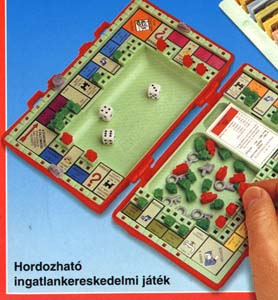 Edition: Monopoly -Travel
Games, ref. 1428H Edition: Monopoly -Travel
Games, ref. 1428H
Publisher: Parker/Tonka Corp./Hasbro Magyarország Kft. - 1994
Dimensions of the case: 5 x 12 x 18 cm
The game:
The red outer box clearly shows a
picture of the inside of this red case.
This variant is a well-reflected and practical travelling companion indeed. The tokens
can be fixed on each space but not more than just one. That means that the next
player landing on the same street has to move one step further. Only on
the corners is sufficient space for 4 players to stay. There are also 4 holes
per street for the houses and hotels.
There are no Chance- nor Surprise cards. Instead you are to
throw three dice and to follow the instruction mentioned in the table
with the corresponding number. Instead of a free ticket to leave Jail you get
one of the 6 keys. Otherwise the rules are the same as those of the
standard game.
These red cases are
made in China.
Suitable for children from 8 years on.
The price amounted to 3,190.- Ft (US$ 23,-) July 1995.
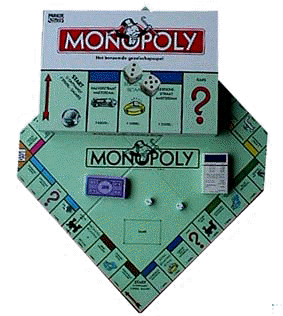 Edition:
Standard,
ref. 14535/165 Edition:
Standard,
ref. 14535/165
Publisher: Tonka Corp./Hasbro Magyarország Kft. - 1996
Dimensions of the box: 26.8 x 40.3 x 5.3 cm
of the double folded board: 25.2 x 25.2 cm
The game:
This edition is a sample of the "new look" of the games manufactured in the Irish
works. The fresh white box shows a red
bar and a part of the fourth side of the board on the cover. The width and the
length of the boxes are standardized for all of their games Hasbro told me. So
herewith the long box we called standard so far disappears.
This new box contains a red plastic tray
insert with newly shaped slots for the banknotes and title cards of the banker.
The board is folded in four like in the so-called "small box".
The back side is red and the play side is blue
green. The set is manufactured in Ireland and so it has again a
picture of a "laughing family" at the back of the box. On the board
are the nice Szerencse- and Meglepetés cards of this game.
The banknotes
are of the new model, i.e. with a black Monopoly ribbon and Uncle Pennybags in
the upper part of the circle and, almost unvisible, the remark "1996 Tonka
Corporation". The 7 denominations are resp.: 100
- 500 - 1.000
- 2.000 -5.000
- 10.000 and 50.000
(ref.nr.1004535 OOA). The 10 tokens are of pewter and likely no longer
manufactured in China.
The green, plastic
houses do have a chimney, the red hotels
haven't.
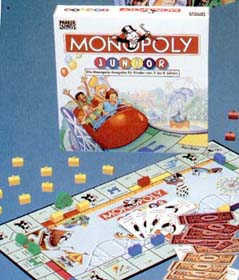 Edition:
Junior
standard, ref. 14540/165 Edition:
Junior
standard, ref. 14540/165
Publisher: Parker Bros./Hasbro Magyarország Kft. - 1996
Dimensions of the box: 26.8 x 26.8 cm
of the oblong board: 25 x 50.5 cm
The game:
Just like in the regular Monopoly game the aim is to collect as much money as
possible. The moment one of the players runs out of money the other players
must count up their money to see who has won the game.
The back of the board is red, like the tray in the box. The game
board is folded vertically. The color picture on the bottom of the box shows a scene of 2
girls and a boy.
Four children can play at the same time, because there are 4 cars,
respectively yellow, red,
blue and green.
The ticket booths are to be
distributed amongst the players with the same
color of car.
The game is a Fun-fair and will be
over in about 20 minutes. Uncle Pennybags brings you to the roller coaster,
magic show, water chute, dodgems, puppet show, miniature golf, a.s.o. When you
land on an Amusement you must pay the amount shown on the space and put
one of your ticket booths on it Now you are owner of that amusement. If you also own the other
amusement of the
same color, a visitor must pay double the amount shown on the space.
There are 6
Chance spaces where cards can be drawn with typical fun-fair instructions. The
sizes of these small cards are 42
x 63 mm.
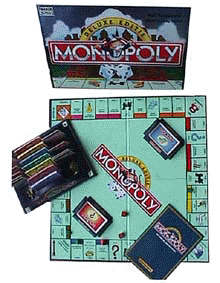 Edition: Monopoly
Luxus Edition, ref. 14549/165 Edition: Monopoly
Luxus Edition, ref. 14549/165
Publisher: Parker Bros./Hasbro Magyarország Kft.
- 1997
Dimensions of the box: 26.8 x 40.3 x 8.8 cm
of the double folded board: 25.2 x 25.2 cm
The game:
Again a great issue of "the famous party game". The box has the same
length and width sizes as the one of the "standard" edition, in
contrast to
the American Deluxe edition, of which the box is still long.
Unfortunately both these boxes are rather vulnerable, but the content is well
taken care of: In the box are, besides the solid game board (with dark
blue back) a soft plastic insert with 4 trays for the houses and
hotels, but in particular the never before used "Banker's Tray",
a well shaped
money-and-cards-holder of solid blue
plastic. You have to put the separate stickers on both this tray as well as the
2 separate card holders (for the Szerencse- and Meglepetés cards) yourself. The
clear color picture at the bottom of the box gives a good total impression of
the set.
This time the lid shows the third side of the game board, so with the
properties Móra park - Szerencse-kártya -
Oskola utca - Dóm tér - Déli Vasútvonal
- Dobó tér -
Almagyar utca
and a part of the tap, on which 2 of the 10
gold colored tokens are to be seen.
The houses and hotels are made of nice glossy wood. The banknotes
are the same as those of the "standard" edition.
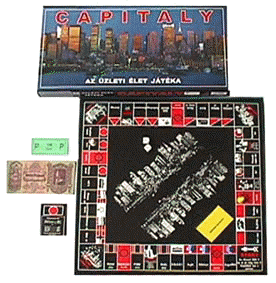 Edition: Capitaly,
b.c. 2094. Edition: Capitaly,
b.c. 2094.
Az üzleti élet játéka (a trade
game)
Publisher: Oliver Games - Budapest - 1997
Dimensions of the box: 48.8 x 24.8 x 5.2 cm
of the board: 46.5 x 47.0 cm
The game:
Taking into consideration the great resemblance of the rules of this issue and
the one of 1986 it is most likely that dr. Seres László (who is mentioned
director in the 1986 issue) is also (former) director of Oliver Games!? However,
I haven't seen his name on the large name-plate at the Oliver Games' entrance in
the Kolostor ut in Budapest.
Although the box of this modern issue is larger and its lid is provided
with a color picture of the New York skyline even this set has great
resemblance with the one of 1986.
The ugly black game board with dark green
back however, is almost square now, as a result of what both sides 1 and 3
contain 10 spaces between the corners while side 2 and 4 have but 9
spaces. The property deeds are just as ugly black as the board, but
have an (unprinted) red back. The Chance cards
are yellow. The 6 tokens are plastic
pawns the heads of which can be taken off. There are 30 houses of white
plastic and 10 hotels of blue
plastic. Both dice are white, one having black pips and the other blue
ones.
It is striking that just now the 7 banknotes have a new design, in no way
reminding of monopoly money. Two large P's have to emphasize the currency (Capitaly)
Pengô.
The price of this set amounted to 4,250.- Ft (US$ 27.-) July 1997.
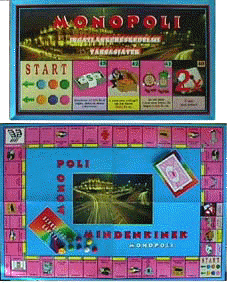 Edition: Monopoli,
Kermi eng.sz.(trade entry nr.): 98/3-00488 Edition: Monopoli,
Kermi eng.sz.(trade entry nr.): 98/3-00488
Mindenkinek
Monopoli (Monopoly for
everyone)
Publisher: K&K - Debrecen - 1998
Dimensions of the box: 5 x 22 x 36 cm
of the board: 43 x 59.8 cm
The game:
The manufacturer K&K has clearly combined elements of both the Parker Monopoly and of Gazdálkodj Okosan.
Besides the name Monopoli (with an i !) he uses precisely all
spaces of the Hasbro game, but …. there are 4 additional spaces. The
double folded game board is rectangular, with 13 spaces along the long
sides and 9 along the short. That's why there are 2 stations on side 3.
The background color of this board of soft cardboard is blue
where as the color of the fields is lilac.
The color bar of the spaces is always yellow
and all fields are numbered, so from 1 to 43 (Start is unnumbered). The treasure
chest on the Meglepetés spaces is brown
and on the Szerencse spaces is a "man-under-umbrella-catching
banknotes". The jail is now, certainly not by accident, on space (13) and
the man on field (35) pointing you back to jail … is the rascal himself. Two
of the stations show the nice, steamlined train mirrored from the others. On the
"Extra Tax" space (38) is not, as you would expect, the "gold-ring-with-diamond",
but a "bundle-of-dollar-notes-with-wings".
The 4 extra spaces also shown on the lid, are resp.:
40. Omit 2 turns!!
41. Time is money. Omit 1 turn but do receive 5.000 Ft.
42. Money cannot buy happiness! Therefore do pay 4.500 Ft.
43. Receive as many times 10.000 Ft as the number of pips thrown.
It is really strange that the 32 houses and 12 hotels are of paper
and still have to be cut out of sheets. It is not clear where these houses
(30x50 mm) and hotels (70x70 mm) have to be placed, because the spaces where
they should lie are but 38 mm wide. As remarkable is the fact the texts of
the Szerencsere- and Meglepetés cards are precisely those of the Parker game, only changed of stack. Why?
Striking are the two different dice: one is yellow
with red pips, the other is green
with red pips.
Similarities with Gazdálkodj Okosan, an other game of inland make, are:
 |
The banknotes bear the image of well-known persons and landmarks,
as they are on the official banknotes. However, the quality of the paper
used is distressingly sallow, as are the property- and other cards. The
Hungarian National Bank never issued notes of 50.000 Ft and that is why they
are called "Bonds" in this game. According to the Rules each
player must get one note of 2,000 Ft, but they simply are not with the set. |
 |
The 6 tokens are chess pawns of colored plastic. |
 |
The cardboard insert of the inner box contains the same
strange cut holes for the attributes as the various issues of Gazdálkodj
Okosan, but this is too little an evidence as to suppose those sets
would have also been manufactured by K&K. |
The price of this set amounted to 2,000.- Ft (US$ 10.-) March 1998.
The next 3 foreign editions are promoted by Hasbro-Hu
on behalf of learning English and German:
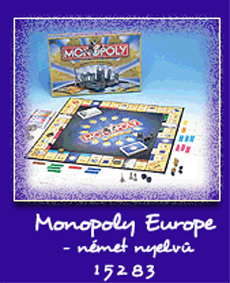 Edition: Monopoly
Europa - German, Ref.Nr. 15283/100 Edition: Monopoly
Europa - German, Ref.Nr. 15283/100
Publisher: Parker/Hasbro - 1999
Dimensions of the box: 27.0 x 40.2 x 6.5 cm
The game:
Of course Parker/ Hasbro took the opportunity of the introduction
of the Euro to issue a special edition again. Was there 1991 talk
of but 12 countries of the European Community, now 15 countries belong to the European Union and
7 countries will join in the years to come. The makers of this game already anticipated by situating
these countries at the beginning of the game. The most expensive properties are the capital cities of the countries who were first to become member. Groups who became member together are partitioned to the size of their capital population.
The capital cities and countries are from Los on:
Vilnius (Lithuania) - Riga
(Latvia) - Sofia (Bulgaria) - Bukarest
(Romania) - Warschau (Poland) - Boedapest
(Hungaria) - Bern
(Switserland) - Helsinki (Finland) - Stockholm
(Sweden) - Wien (Austria) - Lisbon
(Portugal) - Madrid
(Spain) - Athens (Greece) - Dublin
(Ireland) - Copenhagen (Danmark)
- London
(United Kingdom) - Luxemburg
(Luxemburg) - Brussels (Belgium) - Amsterdam
(The Netherlands) - Rome
(Italy) - Berlin (Germany) and Paris
(France).
The 4 stations became the 4 busiest airports of Europe, namely Schiphol (Amsterdam)
- Rhein-Main (Frankfurt) - Paris Charles de Gaulle and London Heathrow. Both utilities became: the European Parliament and the European Court of Justice.
The lid shows enlarged tokens and a banner with "Europa". The bottom of the box shows a nice color picture of the gameboard with all its attributes.
It is a pitty that there are but 8 tokens, a very limited choice out of 22
countries. They are resp.: Brandenburger Tor (Germany) - Manneken Pis
(Belgium) -
Parthenon (Greece) - Templo de la Sagrada Familia (Spain) - Eiffeltower
(France) - Leaning Tower of Pisa (Italy) - The Houses of Parliament
(United Kingdom) and of course a windmill for The Netherlands.
The carefully edited booklet of the
Rules give a detailed explanation of these tokens.
The 7 different banknotes are nice copies of the real €-notes. The € 1's are gold and silver colored (plastic)
coins. On or over
Los you receive € 200. There is no explanation given why the plastic houses with roof edge and chimney are
dark blue and the hotels gold
brown.
Both the dice are dark blue with gold pips.
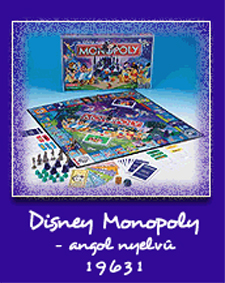 Edition:
Monopoly Disney Edition, Ref.Nr. 19631/102 Edition:
Monopoly Disney Edition, Ref.Nr. 19631/102
Publisher: Parker/Hasbro Inc. - 2002
Dimensions of the box: 26.8 x 40.0 x 6.5 cm
The game:
From Start on all spaces are:
Tarzan - Fascinating
World - Toy
Story - Pocahontas - Snow
White - Jail - Dumbo -
Wand - The Beauty and the Beast - Arielle,
the Mermaid - Captain Hooks Pirate boat - Red
and Toby - Fascinating
World - Bianca
& Bernie - Jungle book - Free
Parking - Steamboat Willie - Sleeping
Beauty - Lady and the Tramp - Cinderellas
coach - Mulan
- Alice in Wonderland -
Elfs dust - Cinderella
- Go to Jail - Bambi
- Aladdin - Fascinating
World - Pinocchio
- Cruella De Vils car
- Showtime - The Lion King - Tax
to Prince John
and 101 Dalmation.
The Chance cards became Fascinating
World cards, while the Community Chest cards are here Show Time cards.
The money consists of colored notes with the amount to the left and the
right and Uncle Scrooge inbetween as Mr.Monopoly.
The 8 tokens are Disney characters as they appear in the stories: Peter
Pan - Snow White - Pinocchio - Lady and the Tramp - Dombo - Alice - Tarzan and Sleeping
Beauty.
The set goes with 32 green "White
Rabbit Cottages" and 12 blue "Sleeping
Beauty Castles".
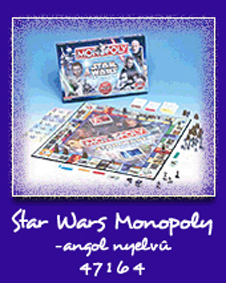 Version:
Star Wars - Episode II , Ref. Nr. 47164/102 Version:
Star Wars - Episode II , Ref. Nr. 47164/102
"Collectors Edition"
Publisher: Parker/Lucasfilm Ltd./Hasbro - Febr.
2002
Dimensions of the box: 26.8 x 40.0 x 6.5 cm
The game:
This is a 4th version of Star Wars and the 2nd
after the film: Attack of the Clones.
The text on the bottom of the box reads:
"Rush into the fray to rule over the Galaxy!
In this special edition of Monopoly you take part of the great great war
against the Clones yourself. Choose one of the 8 tokens – you decide
yourself if you choose for the Dark or Brite side. Follow an intergalactic way
over the game board meanwhile collecting as many Republican Credits as
possible!
The special "force' die and counters offer an additional challenge
if you have to measure your strength with the other part of the fight for
supreme mastery. Do Obi-Wan Kenobi and Yoda de Jedi je lead to victory? Or
will this be the chance the malicious count Dooku and Jango Fett are waiting
for so long? The one who knows how to prevent a bankrupcy will finally triumph.
May
the Force be with you!"
The Chance
and Community Chest cards have been replaced by Jedi
and Sith cards.
The 8 pewter tokens are: Obi-Wan
Kenobi - Anakin Skywalker - Padmé Amidala - Mace Windu
- a Clone Trooper of the Brite side - Count Dooku - Jango and
a Superfighter droďde of the Dark side.
The currency of the Star Wars banknotes is Republican Credit. The houses
and hotels have been replaced by Appartments and Towers.
Except for the 2 common dice there is also a Force-die supplied
this time.
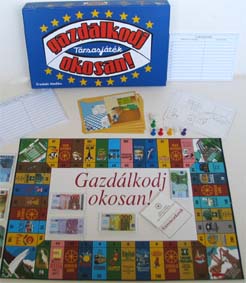 Edition: Gazdálkodj (társasjáték)
okosan!, b.c. 154360 Edition: Gazdálkodj (társasjáték)
okosan!, b.c. 154360
Eredeti kiadás (special edition)
Publisher: Oliver Games Kft./Minerva Kiadó/Regio Kft. - 2002
Dimensions of the box: 24.2 x 40.2 x 6.5 cm
of the board: 39.1 x 56.3 cm
The game:
In prospect of Hongary to joint the European community the Oliver Games company
has taken the opportunity to issue a modern version of the originally communist
game Gazdálkodj okosan! as issued in the 60's. Indeed an interesting challenge.
It immediately attract attention that the typical blue
lid shows 18 yellow
stars. The solid game board is less heavy than the 1960-one and slightly
smaller. Whereas the 1960-one has one fold this new board has 2 folds parallel
to the smallest side and fits inside the box. The division of the game board is
a copy of the 1960 edition, however the design is of this era.
As usual the aim of the game is to collect that much that a house can be bought
and subsequently furnished with this time more modern furniture for the
living room and kitchen as well as a vacuum cleaner, washing machine,
a TV and a VCR. The first player to furnish the house and additionally
has saved at least € 2,000 Ft is the winner.
To that end each player get a house-plan in which he has to fill up only 6
parts as in the early issue.
Some examples of the updating of the spaces:
nr.1: While at this space was a pub only , it
now is a wine bar.
nr. 2: OTP was the country's savings bank, where a saver gets 5%
interest on his bonds; now the OTP is a bank where one opens a current account,
incl. a credit card, at an interest of 7%.
nr.20: Previously there was a cigarette shop at this space; now it
is a mobile shop.
nr.35: Previously you had to pay a fine of 10 Ft. for crossing the street
at a wrong place; nowadays you buy yourselfs a new car and pay € 200 leasing
fee.
There are 41 spaces, the same as in the 1960 issue, of which 6x Szerencsekerék (Wheel
of Fortune). There are but 36 white
Wheel of Fortune cards (55x80 mm), whereas the 1960 issue had 46. The money consists of
6 very nice Euro banknotes one sided color printed: 20
- 50 - 100
- 200 -
1000 and 5000. Each player receives
€17,100 at the start of the game. On/over Start the OTP Bank pays
you € 4000/2000.
The tokens are 6 chess pawns of
colored plastic. The one die is white with black pips.
The innerbox contains an insert of solid white plastic
with 9 trays.
As said at the bottom of the box this set contains a free ticket for the
Budapest Zoo. However the free ticket in my box was only valid from October
2002 till March 2003 and from October 2003 till March 2004.
Another Budapest chance was to get a free Gundul pancake in case the box
contained a free ticket for that. Unfortunately mine hadn't.
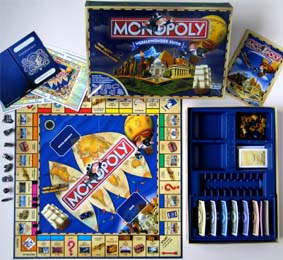 Edition:
Világcsodák (Wonders of the world), ref. 48285/165 Edition:
Világcsodák (Wonders of the world), ref. 48285/165
Publisher Parker/Hasbro Magyarország Kft. - 2003
Dimensions of the box: 27 x 40.3 x 6.5 cm
The game:
This very nice special edition shows Mr. Monopoly in a balloon on the lid as
well as on the game board.
In this issue the properties are 22 of the most impressive and well-known
wonders of the world. On the mortgage side of the property deeds is a short history.
The stations have been replaced by European airports. All fields are from
Start onwards:
Niagara Falls - Meglepetés-kártya (surprise
card) - Mount Everest - Utasbiztosítás
(travel insurance) - Amsterdam Schiphol - Great
Barrier Reef -Szerencse-kártya
(luck card)
- Grand Canyon - Angel
Falls -
Börtön/Csak látogatóban (jail
- just visiting) - Cristo
Redentor - Pénzváltó
hely (exchange
office)
- Eifel Tower - Colosseum
- Paris Charles De Gaulle - Stonehenge
- Meglepetés-kártya
- Taj Mahal - Moai szobrok
(sculptures)-
Ingyen parkolhatsz! (free
parking) - Machu
Picchu - Szerencse-kártya - Angkor Wat
- Petra - Rhein-Main Frankfurt Int. -
Nagy Fal
(large wall) -
Pharos,
Alexandria - Utazási iroda (travel
agent)
- Colossus,
Rhodos -
Irány a börtön (Go
to jail) - Mauzóleum,
Halicarnassus - Zeus
Szobora, Olympia -
Meglepetés-kártya - Artemis
Temploma, Efeze - London Heathrow - Szerencse-kártya - Lelógus kertek (hanging
gardens)- Répülôtéradó
(airport
tax)
and Nagy
Piramis, Gizeh.
The spaces have numbers pointing to the places in the world where these
landmarks are situated.
Note that the treasure chest is brown
instead of blue. The instructions on the
cards are adapted to this issue. Examples are:
 |
Caught food poisoning. You receive € 50 compensation. |
 |
Pay € 100 for vaccinations. |
 |
Family packing of diarrhoea pills! Pay € 20. |
 |
You win a poker match in the hostel. You receive €
50. |
The heavy metal tokens are no world wonders but copies of inventions
of transport means, i.e.: warrior-waggon - canoe - balloon
- bicycle - steamengine - clipper - airplane and car.
The innerbox has one large dark blue
plastic tray with 4 big holes to store the houses and hotels and 2 rows of slots
for the banker's cards and banknotes. The € banknotes are those
from earlier editions.
The plastic houses are dark blue, the
hotels are beige. Both wooden dice
are dark blue and have gold pips.
The color picture on the bottom of the box clearly shows all details of this
set.
The specialty in this edition are those 4 plastified passports.
The aim is to land on each of the streets and mark them in your passport. The
first player to visit all world wonders receives a bonus of € 1500. This is
also the moment the game ends.
The crosses can be removed from the passports by a dark
blue cloth supplied with the game.
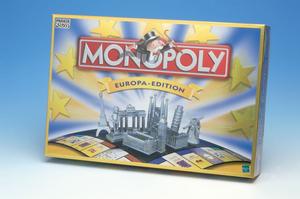 Edition:
Europa kiadás, ref. 15283/165 Edition:
Europa kiadás, ref. 15283/165
Publisher: Parker/Hasbro, Magyarország Kft.
- 2004
Dimensions of the box: 6.5 x 26.8 x 40.1 cm
The game:
See for the description of this edition, issued around May 1, 2004 as 7 new
countries (amongst which Hungary) entered the European Community, what is
said about the German version, earlier in this chapter.
CITY GAMES
The inland manufacturer of all
Capitaly editions is Oliver Games Kft. - Kolostor u. 30 - 1037 Budapest.
This company started in 2000 making carefully edited games of Hungarian
cities.
Publication of these city games is possible because of the sponsoring by local
companies and institutions mentioned on the spaces. The
design of these Capitaly 2000 City editions is the same for all issues,
namely:
 |
The maroon
lid shows a color picture of the city's townhall next to the
colorfull city arms in a white field. |
 |
The bottom of the box shows the
same color picture of the townhall. Next to that is a story of the city
accompanied with a recommendation by the mayor, an enumeration of participating
companies as well as a listing of the first 15 cities. |
 |
The innerbox contains a black
plastic "bankers' tray" with 10 holes. |
 |
Whereas the common Capitaly edition has 10 spaces between the corners
on side 1 and 3 and but 9 on side 2 and 4 this are 8 spaces on all sides
of these slightly smaller square game boards. |
 |
The Start corner always shows the
townhall picture again. |
 |
Rather than color bars the spaces show
the same "Capitaly symbols" (crosses, balls, triangles) but
in different order. |
 |
The game board's back side is different
in color for each issue. |
 |
The main colors on the board as well as
of the property deeds (65x100 mm) are dark
blue and red. |
 |
The Szerencsekerék (wheel
of fortune) cards (50x80 mm) are white. |
 |
The denominations of the one sided color
printed 7 Oliver Games banknotes (51x80 mm) are in Euro's:
500 -1.000
- 2.000 - 5.000
- 10.000 - 20.000
and 50.000. |
 |
Contrary to Monopoly the starting salary
is not, like in all Capitaly issues, divided into an obligatory number of
composing denominations. |
 |
Each issue contains 2 special spaces:
 |
At the one you only may proceed when your throw
shows equal or unequal numbers, so 2 and 4 or 3 and 5. |
 |
The player which lands on the "Viessmann"
space gets the opportunity to install modern, energy saving and
environment friendly boilers in his real estates. If he pays the bank
€ 500 per house he'll receive a socalled "Vriessmann
sticker" he has to put upon the concerning property. Its value so
is quadrupled. |
|
 |
The houses are white, the almost same sized hotels
blue. |
 |
The 6 tokens are plastic chess pawns. |
 |
The Rules are in a large sized white
booklet also containing whole page sized stories of only a few of
the sponsors. |
The first two issues are those of:
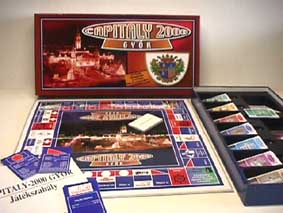 Edition:
Gyôr, b.c. 100136 Edition:
Gyôr, b.c. 100136
Publisher: Oliver Games Kft. - 2000
Dimensions of the box: 25 x 49 x 5.3 cm
The game:
The Rules of this edition says: "Capitaly is a 66 years old game.
Originally Pengô was the currency."
This means the game originates from about 1934, which confirms what I've said in
the first set described above.
Features of this edition are:
 |
Both the lid and innerbox
are dull. |
 |
This first City game has
one more banknote than usual.
It is a green note of € 100. There is
no explanation for it. |
 |
Players start with a
capital of € 80.000. |
 |
The game board's back is grey. |
 |
Both dice are white,
one with blue pips and one with black
ones. |
 |
There are 19 sponsors for
this issue. |
The story about Gyôr at
the bottom of the box says:
"At the time of the
foundation of the state Gyôr was the bishop's recidence. In 1271 it was given
the rights and privileges of a municipal corporation by Stephan V. It was one
of the important border settlements at the time of the Turkish conquests. The
castle was captured by the Turks in1594, it had however to be returned already
4 years later. Gyôr celebrated its 400th birthday of the
liberation from the Turkish mastery 1988.
The city, called Arrabona by the Celts, develloped very versatile in the 16th
and 17th century; it became centre of craft industry and
trade. 1743 Maria Teresia declared it her sovereign royal city, she stimulated
in its further growth. The revolution taking place in the previous century
brought a strong industrialisation and the greatest changes in the city's
live; in that time the manufacture of vehicles and machines, the texile and
food industry obtained a foothold in Gyôr and today they still are the image
of the town.
Considering its size and number of inhabitants Gyôr is only the 5th
city of Hungary, however considering its importance in economy its part
in this is of vital importance. Because of its develloped infrastructure, the
high intellectual level and the trained workers numerous foreign investments
have been drawn to this region. This traditionally industrial nature recedes
these days somewhat into the background because of the versatility in
cultural, intellectual and sporty live, apart from the beautiful baroque city
centre and its enormous monuments.
Gyôr also is a festival town: the Spring Festival of
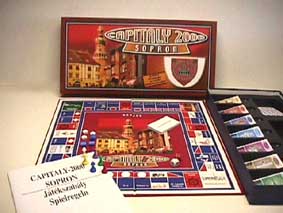 Edition:
Sopron, b.c. 100129 Edition:
Sopron, b.c. 100129
Publisher: Oliver Games Kft. - 2002
Dimensions of the box: 25 x 49 x 5.3 cm
The game:
Features of this edition are:
 |
The Rules are bilingual because ...... |
 |
This first City game has
one more banknote than usual.
It is a green note of € 100. There is
no explanation for it. |
 |
Players start with a
capital of € 80.000. |
 |
The game board's back is grey. |
 |
Both the lid and innerbox
are glossy. |
 |
There are 19 sponsors for
this issue. |
The story about Sopron at
the bottom of the box says:
"Sopron, so the story
tells, has been built of stones from the former Roman city Scarbantia. It is
one of Hungary's most tourist towns, the country's gate to the west,
situated between the Fertô lake and the Sopron mountains, along the Ikva
bank.
It has a history of over 1000 years because it has always been an occopied
location. For their loyalty the inhabitants of this settlement in 1277 got
the status of free royal town from our king László IV.
In the coarse of history of the city very important events took place like
country meetings and coronations of kings. With the famous plebiscite of December
14th, 1924 (this should be 1921, see
http://www.sopron.hu/)
where was decided to which country the city should belong, the result was
Sopron to stay with Hungary thanks to the loyalty (64%)
of its population. Since that moment the town is allowed to bear the
honourable title "Civitas
Fidelissima", the most loyal city.
Because of its favourable geographic situation, its unique historic and
natural values, its healing climate, its healing and recreative
possibilities, its multitude of landmarks in the vicinity, its brimming
cultural life, its scientific and commercial international relations, its
luxurious hospitality and its good wines rightly made Sopron one of the
country most important tourist centres, well-known all over the world."
The editions of the next 13 cities to come:
Vác - Eger - Pécs - Szeged - Debrecen - Miskolc
- Székesfehérvár - Veszprém - Szombathely - Kecskemét
- Nyíregyháza - Zalaegerszeg and Szolnok.
|